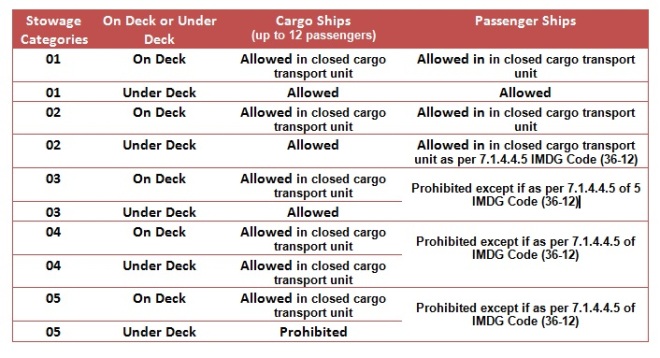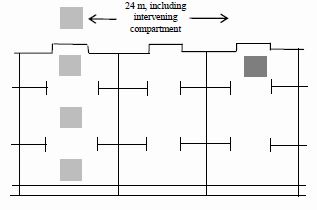In this post we will check how to decide whether two explosives can be safely stored or transported together.
Class 1, Explosives, are considered compatible with each other if storing them or transporting them together will not increase the probability of an accident or if there is an accident the magnitude of the effects. For this purpose explosives are divided into various compatibility groups. Each group is denoted by an alphabet from A to L, N and S (letter I is not used).
Divisions of Class 1 Explosives
- Division 1.1: substances and articles which have a mass explosion hazard
- Division 1.2: substances and articles which have a projection hazard but not a mass explosion hazard
- Division 1.3: substances and articles which have a fire hazard and either a minor blast hazard or a minor projection hazard or both, but not a mass explosion hazard
- Division 1.4: substances and articles which present no significant hazard
- Division 1.5: very insensitive substances which have a mass explosion hazard
- Division 1.6: extremely insensitive articles which do not have a mass explosion hazard
Compatibility Groups and Classification Codes
| Compatibility group |
Classification code |
Description of substance or articles |
| A |
1.1A |
Primary explosive substance |
| B |
1.1B1.2B1.4B |
Article containing a primary explosive substance and not containing two or more effective protective features. Some articles, such as detonators for blasting, detonator assemblies for blasting and primers, cap-type, are included even though they do not contain primary explosives. |
| C |
1.1C1.2C1.3C1.4C |
Propellant explosive substance or other deflagrating explosive substance or article containing such explosive substance |
| D |
1.1D1.2D1.4D1.5D |
Secondary detonating explosive substance or black powder or article containing a secondary detonating explosive substance, in each case without means of initiation and without a propelling charge, or article containing a primary explosive substance and containing two or more effective protective features |
| E |
1.1E1.2E1.4E |
Article containing a secondary detonating explosive substance, without means of initiation, with a propelling charge (other than one containing a flammable liquid or gel or hypergolic liquids) |
| F |
1.1F1.2F1.3F1.4F |
Article containing a secondary detonating explosive substance with its own means of initiation, with a propelling charge (other than one containing a flammable liquid or gel or hypergolic liquids) or without a propelling charge |
| G |
1.1G1.2G1.3G1.4G |
Pyrotechnic substance, or article containing a pyrotechnic substance, or article containing both an explosive substance and an illuminating, incendiary, tear- or smoke-producing substance (other than a water-activated article or one containing whitephosphorus, phosphides, a pyrophoric substance, a flammable liquid or gel, or hypergolic liquids) |
| H |
1.2H1.3H |
Article containing both an explosive substance and white phosphorus |
| J |
1.1J1.2J1.3J |
Article containing both an explosive substance and a flammable liquid or gel |
| K |
1.2K1.3K |
Article containing both an explosive substance and a toxic chemical agent |
| L |
1.1L1.2L1.3L |
Explosive substance or article containing an explosive substance and presenting a special risk (such as due to water-activation or presence of hypergolic liquids, phosphides or a pyrophoric substance) and needing isolation of each type |
| N |
1.6N |
Articles containing only extremely insensitive detonating substances |
| S |
1.4S |
Substance or article so packaged or designed that any hazardous effects arising from accidental functioning are confined within the package unless the package has been degraded by fire, in which case all blast or projection effects are limited to the extent that they do not significantly hinder or prohibit fire fighting or other emergency response efforts in the immediate vicinity of the package |
To check whether two explosives are compatible to be stored/transported together the transport regulation has a segregation table as shown below.
 Notes for above table
Notes for above table
“X” indicates that goods of the corresponding compatibility groups may be stowed in the same compartment, magazine, cargo transport unit or vehicle.
Notes:
1 Explosive articles in compatibility group G (other than fireworks and those requiring special stowage) may be stowed with explosive articles of compatibility groups C, D and E provided no explosive substances are transported in the same compartment, magazine, cargo transport unit or vehicle.
2 A consignment of one type in compatibility group L shall only be stowed with a consignment of the same type within compatibility group L.
3 Different types of articles of Division 1.6, compatibility group N, may only be transported together when it is proven that there is no additional risk of sympathetic detonation between the articles. Otherwise they shall be treated as Division 1.1.
4 When articles of compatibility group N are transported with articles or substances of compatibility groups C, D or E, the goods of compatibility group N shall be treated as compatibility group D.
5 When articles of compatibility group N are transported together with articles or substances of compatibility group S, the entire load shall be treated as compatibility group N.
6 Any combination of articles in compatibility groups C, D a nd E shall be treated as compatibility group E. Any combination of substances in compatibility groups C and D shall be treated as the most appropriate compatibility group shown in 2.1.2.3 of IMDG Code, taking into account the predominant characteristics of the combined load. This overall classification code shall be displayed on any label or placard placed on a unit load or cargo transport unit as prescribed in 5.2.2.2.2 of IMDG Code
Example compatibility check
With the above table let us check segregation requirement between below two explosives
- UN 0161 Class 1.3C, POWDER, SMOKELESS
- UN 0191 Class 1.4G, SIGNAL DEVICES, HAND
Segregation between compatibility letters C and G shows X1 and as per note x1 explosive articles of group G ( UN 0191 in this case) may be stowed with explosive articles of group C, D and E provided no explosive substances are loaded in the same container, UN 0161 is a substance hence cannot be loaded with UN 0191.
Applicable sections of IMDG Code for compatibility groups and segregation within explosives please refer to section 2.1.2 & 7.2.7















